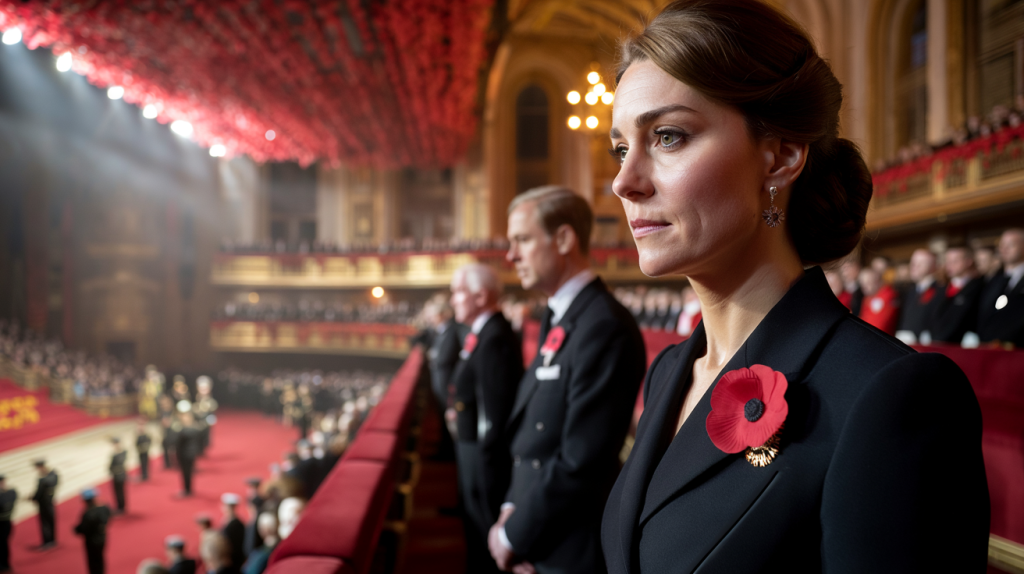A hush falls, 100,000 poppy petals drift from the roof, and cameras find Kate Middleton. The Festival of Remembrance turns the Royal Albert Hall into a living memorial, and the Princess of Wales often becomes the quiet focal point of a night built on service, loss and gratitude.
Held every November at London’s Royal Albert Hall, the Festival is staged by the Royal British Legion on the Saturday before Remembrance Sunday. Since 1923, it has brought veterans, serving personnel and the royal family together, with Kate Middleton, Prince William, King Charles III and Queen Camilla attending the evening performance that is broadcast on BBC One.
Kate Middleton and the Festival of Remembrance: what people want to know
Searches spike for Kate Middleton each November for simple reasons. Will the Princess of Wales attend, what will she wear, and what does it actually signify in the context of national remembrance.
The format is consistent. Music from military bands, testimonies from veterans and families, and an Act of Remembrance anchor the evening. The moment that defines it is the two-minute silence, echoed nationwide the next day at 11:00 on Remembrance Sunday to mark the Armistice of 11 November 1918.
Presence matters here more than words. Kate Middleton’s attendance signals continuity of support for the Armed Forces community, a cause long tied to her work on early childhood, mental health and military families. The setting amplifies it. The Royal Albert Hall seats roughly 5,272 people, yet the mood feels intimate as the last note fades and petals begin to fall.
Royal Albert Hall, poppies and the numbers that frame the night
The Festival has taken place at the Royal Albert Hall since 1923, according to the venue’s own history. The Royal British Legion curates the program and links it to the annual Poppy Appeal, which funds support for veterans and their loved ones across the UK.
Those 100,000 poppy petals are not decorative. They represent lives lost in service, a visual count that lands with force when the audience stands and the hall falls still. The cadence builds toward that silence, then releases into the rousing chorus of “God Save the King.”
Broadcast on BBC One, the evening often includes tributes tied to milestones. In 2023, audiences saw segments reflecting the 70th anniversary of the end of the Korean War, alongside salutes to service families who hold the line at home. The balance is deliberate, part ceremony, part storytelling grounded in fact.
Style, symbolism and the role Kate Middleton plays
Kate Middleton’s fashion choices are restrained for this event. Black tailoring, minimal jewelry, hair swept up so the poppy brooch sits clear against the fabric. The poppy is non-negotiable, the signal that unites the hall. At times, the Princess has worn pieces with personal resonance, such as the Codebreakers Brooch linked to Bletchley Park, where her grandmother Valerie Glassborow served during the Second World War.
The symbolism is simple. No statement coats, no bright colour to pull focus, just detail and respect. Royal watchers parse the silhouette and accessories, yet the reading that matters most on the night comes from veterans’ faces and the families who recieve the loudest applause.
Her role bridges protocol and people. Before the show, Catherine, Princess of Wales, meets serving personnel and bereaved families in quiet moments off camera. During the performance, she stands with the royal family for the Act of Remembrance, then acknowledges participants with brief, visible thanks. It is measured, and it fits the tone.
For context, the Festival is not the end point. It leads directly into Remembrance Sunday at the Cenotaph on Whitehall, where a national service and wreath laying takes place the next morning. At 11:00, a two-minute silence halts central London as the Last Post sounds. Kate Middleton typically watches from a Foreign, Commonwealth and Development Office balcony while senior royals lay wreaths below.
The schedule rarely changes. Saturday night at the Royal Albert Hall for the Festival, Sunday morning for the Cenotaph, both anchored in remembrance and broadcast nationwide. That rhythm helps explain why the images of Kate Middleton in black with a poppy brooch resonate each year. They slot into a tradition that has marked British November for more than a century, from 1918’s silence to the petals that still fall today.
